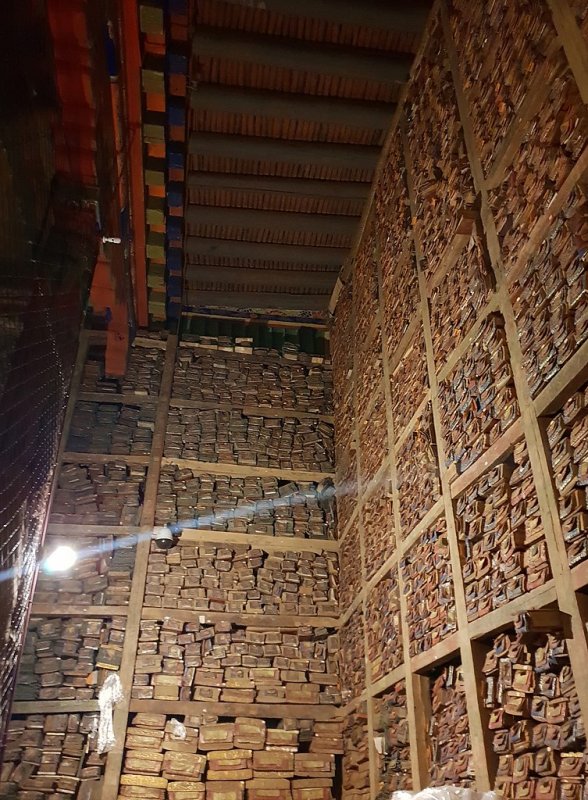Jan Bartek – AncientPages.com – One of the most incredible ancient libraries one can encounter is located inside the Sakaya monastery in Tibet. The great Sakaya library is home to 84,000 scrolls that have remained untouched for hundreds of years!
Being examined by the Tibetan Academy of Social Sciences, it is now known these ancient scrolls contain valuable knowledge on various subjects.

Sakya Monastery Library. Credit: Richard Mortel – CC BY 2.0
According to the Indian scholar of Tibetan language and culture, Das Sharat Chandra (1849 – 1917), “the great library of Sakya, is on shelves along the walls of the great hall of the Lhakhang Chen-po. There are preserved here many volumes written in gold letters; the pages are six feet long by eighteen inches in breadth. In the margin of each page are illuminations, and the first four volumes have pictures of the thousand Buddhas.
These books are bound in iron. They were prepared under the orders of Emperor Kublai Khan and presented to the Phagpa lama on his second visit to Beijing.
There is also preserved in this temple a conch shell with whorls turning from left to right [in Tibetan, Ya chyü dungkar ], a present from Kublai to Phagpa. It is only blown by the lamas when the request is accompanied by a present of seven ounces of silver, but to blow it, or have it blown, is held to be an act of great merit.” 1
When searching for more information about this incredible library, sometimes posts on social media state secret manuscripts in the Sakaya monastery detail more than 10,000 years of human history. It is also claimed that this is “possibly the largest library in the world on the distant history of the planet. It was discovered behind a huge wall”. 2
This would truly be extraordinary if true, but is it? While researching the monastery’s history and its library, we here at Ancient Pages can say we have not found any evidence supporting these claims.

Sakya Monastery, Sakya, Tibet. Credit: Moszczynski – Public Domain
It is possible, though not confirmed that some of the scrolls kept at the Sakya library may have been transferred from Nalanda, one of the most praised learning centers of the ancient world.
“By the time the first European university was established in Bologna in 1088, Nalanda had been providing higher education to thousands of students from Asian countries for more than six hundred years.
The university was an architectural and environmental masterpiece. It had eight separate compounds, 10 temples, meditation halls, classrooms, lakes, and parks.” 3
We know that the Sakaya monastery was founded in 1073 by Konchok Gyelpo, who established the Sakya School of Tibetan Buddhism.
“Sakaya tradition, founded by the Drogmi, one of the leading tantric masters of the Vikramsila University, in Shigatse in the Tsang province of Tibet, is one of the major sects of Tibetan Buddhism. Later, Khon Konchok Gayalpo, the discipline of Drogmi, built the first Sakaya monastery in Tibet. Unlike, the other tradition, this sect holds some special features regarding its lineage of the Khon family.
The Khon is the name of the family or the group of individuals who were believed to be the progenitor of the divine or celestial family. Besides, this lineage holder played a significant role in the propagation and development of Buddhism in their mainland as well as in their neighboring countries such as China, Mongolia and present Ladakh region (India.)” 4

The Sakya library offers an incredible amount of knowledge. Credit: – CC BY 2.0
The Great Sakya Monastery has once had 500 monks. However, political tensions made it impossible to remain in the monastery. By the end of 1959, only 36 aged monks remained, and large parts of the monastery were destroyed during the Cultural Revolution. “At present, there is a total of 205 monks comprising the school, college, and monastery who are currently practicing the union of both Sutra and Tantra in the midst of quite a sufficient facility.” 5
According to the Sakya Monastery’s official site, the great library is open. It aims to facilitate the students with all kinds of books from any school of philosophy at all times.
The great library of the Sakya is not well-known and does not boast about its existence to the outside world, but it is without question a vast repository of knowledge.
Genuine knowledge seekers tend to find their way to places where knowledge exists, and the Sakya great library is worth visiting if one has the chance.
Written by Jan Bartek – AncientPages.com Staff Writer
Updated on September 14, 2022
Copyright © AncientPages.com All rights reserved. This material may not be published, broadcast, rewritten or redistributed in whole or part without the express written permission of AncientPages.com
Expand for references
- Sarat Chandra Das – Journey to Lhasa and Central Tibet
- AAP – Claim of 10,000-year-old Tibet library find not worth paper it’s written on
- Sutherland – Nalanda – One of the Most Praised Learning Centers And Masterpiece Of Ancient World, AncientPages.com
- Lamo, Sonam. “Sakya Tradition in Tibet & Ladakh Region.” The Tibet Journal44, no. 1 (2019): 19-26.
- Sakya Monastery Organization





